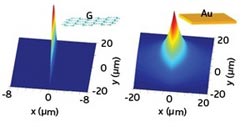Photonics: Graphene’s flexible future

Plots showing that surface plasmons are more confined when propagating along on a monolayer of graphene (G) than they are along a thin film of gold (Au).<br><br><br><br>Copyright : 2012 A*STAR Institute of High Performance Computing <br>
Semiconductors have revolutionized computing because of their efficient control over the flow of electrical currents on a single chip, which has led to devices such as the transistor.
Working towards a similar tunable functionality for light, researchers from the A*STAR Institute of High Performance Computing (IHPC), Singapore, have shown how graphene could be used to control light at the nanometer scale, advancing the concept of photonic circuits on chips1.
Graphene, which is made from a single layer of carbon atoms, has excellent electronic properties; some of these are also useful in photonic applications. Usually, only metals are able to confine light to the order of a few nanometers, which is much smaller than the wavelength of the light.
At the surface of metals, collective oscillations of electrons, so-called ‘surface plasmons’, act as powerful antennae that confine light to very small spaces. Graphene, with its high electrical conductivity, shows similar behavior to metals so can also be used for plasmon-based applications, explains Choon How Gan of IHPC, who led the research.
Gan and co-workers studied theoretically and computationally how surface plasmons travel along sheets of graphene. Even though graphene is a poorer conductor than a metal, so plasmon propagation losses are higher, it has several key advantages, says team member Hong Son Chu. “The key advantage that makes graphene an excellent platform for plasmonic devices is its large tunability that cannot be seen in the usual noble metals,” he explains. “This tunability can be achieved in different ways, using electric or magnetic fields, optical triggers and temperature.”
The team’s calculations indicated that surface plasmons propagating along a sheet of graphene would be much more confined to a small space than they would traveling along a gold surface (see image). However, the team also showed that surface plasmons would travel far better between two sheets of graphene brought into close contact. Furthermore, by adjusting design parameters such as the separation between the sheets, as well as their electrical conductivity, much better control over surface plasmon properties is possible.
In the future, Gan and his co-workers plan to investigate these properties for applications. “We will explore the potential of graphene plasmonic devices also for the terahertz and mid-infrared regime,” he explains. “In this spectral range, graphene plasmonic structures could be promising for applications such as molecular sensing, as photodetectors, or for optical devices that can switch and modulate light.”
The A*STAR-affiliated researchers contributing to this research are from the Institute of High Performance Computing
Journal information
Gan, C. H., Chu, H. S. & Li, E. P. Synthesis of highly confined surface plasmon modes with doped graphene sheets in the midinfrared and terahertz frequencies. Physical Review B 85, 125431 (2012)
Media Contact
All latest news from the category: Materials Sciences
Materials management deals with the research, development, manufacturing and processing of raw and industrial materials. Key aspects here are biological and medical issues, which play an increasingly important role in this field.
innovations-report offers in-depth articles related to the development and application of materials and the structure and properties of new materials.
Newest articles

Properties of new materials for microchips
… can now be measured well. Reseachers of Delft University of Technology demonstrated measuring performance properties of ultrathin silicon membranes. Making ever smaller and more powerful chips requires new ultrathin…

Floating solar’s potential
… to support sustainable development by addressing climate, water, and energy goals holistically. A new study published this week in Nature Energy raises the potential for floating solar photovoltaics (FPV)…

Skyrmions move at record speeds
… a step towards the computing of the future. An international research team led by scientists from the CNRS1 has discovered that the magnetic nanobubbles2 known as skyrmions can be…





















